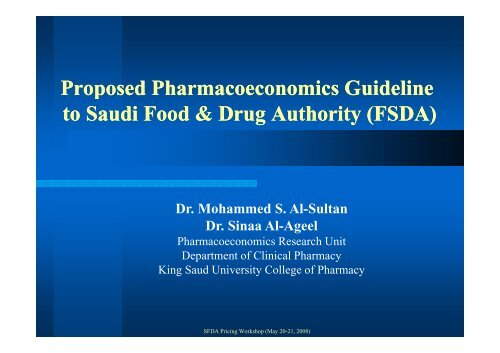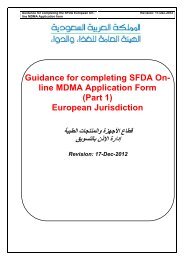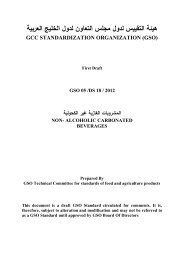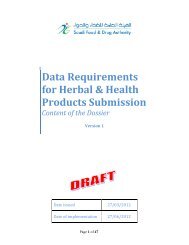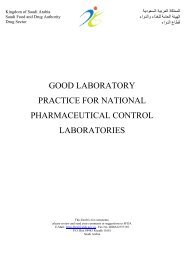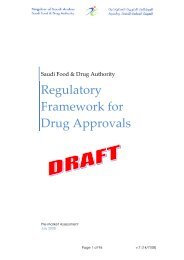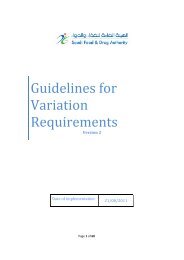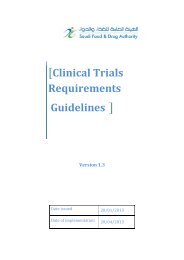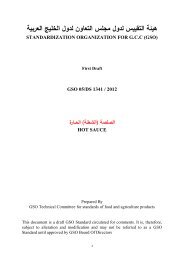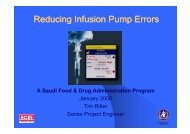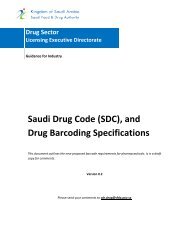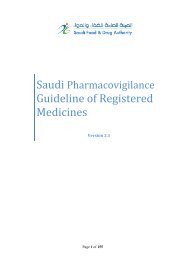Proposed Pharmacoeconomics Guideline p to Saudi Food & Drug ...
Proposed Pharmacoeconomics Guideline p to Saudi Food & Drug ...
Proposed Pharmacoeconomics Guideline p to Saudi Food & Drug ...
- No tags were found...
Create successful ePaper yourself
Turn your PDF publications into a flip-book with our unique Google optimized e-Paper software.
<strong>Proposed</strong> <strong>Pharmacoeconomics</strong> <strong>Guideline</strong><strong>to</strong> <strong>Saudi</strong> <strong>Food</strong> & <strong>Drug</strong> Authority (FSDA)Dr. Mohammed S. Al-SultanDr. Sinaa Al-Ageel<strong>Pharmacoeconomics</strong> Research UnitDepartment of Clinical PharmacyKing Saud University College of PharmacySFDA Pricing Workshop (May 20-21, 2008)
Presentation Outline<strong>Pharmacoeconomics</strong> guidelines: international experienceTo present the proposed SFDA pharmacoeconomics guidelines
Situations where economic evaluations canassist decision makers:• Decisions by various levels of government or administrative bodies(e.g., different health care sec<strong>to</strong>rs, hospitals, health insurancecompanies) <strong>to</strong> fund a program, service or technology.• Pricing decisions by government regula<strong>to</strong>rs and technologymanufacturers.• Clinical practice guidelines.• Post-marketing surveillance and updates of economic informationbased on the use of the technology in the “real world” (which can thenbe used <strong>to</strong> inform one of the other types of decisions).• Regulate cost effectiveness claims by pharmaceutical Companies
<strong>Pharmacoeconomics</strong> guidelines: Internationalexperiences
International Experiencee • Several jurisdictions have imposed a ‘FourthHurdle’ or requirement for economic data as par<strong>to</strong>f pricing/reimbursement decisions for drugs.• The new requirements are usually accompaniedq y pby a set of guidelines for company submissions.
International Experience• In 1992, Australia became the first country <strong>to</strong> formalise and issue manda<strong>to</strong>ryguidelines for health economics evaluations of pharmaceutical products as arequirement prior <strong>to</strong> reimbursement• Currently more than 32 guidelines around the world•Most experience relates <strong>to</strong> pharmaceuticals, although some countries havecentral programmes for evaluating (e.g. The Netherlands, UK).•The scope of requirements differs from place <strong>to</strong> place:All new drugs (Australia, Canada, Scotland),<strong>Drug</strong>s where a premium price is requested (the Netherlands )<strong>Drug</strong>s with a major impact (England and Wales, Portugal )
International ExperienceReimbursement/ ListingPurposeMethodological StandardsSourceGovernment/Payers BelgiumCanada (2 provinces)LDI Task Force (USA)Rovira et al(Spain)FinlandHungaryIrelandThe NetherlandsHannover (Germany)BESPE (Belgium)BMJ Working Party (UK)Garattini et al(Italy)New ZealandCollege of Economists (France)NorwayPortugalSwedenUnited KingdomAcademiaLangley et al (USA)PHrMA (USA)Alban et al (DK)IndustryPHrMA (USA)
International ti lE ExperienceHjelmgren et al report agreement on 75% of methodologicalprinciplesi The main differences are in guidance on:– study perspective (e.g. inclusion of non-healthcarecosts)– economic outcomes (e.g. QALYs, WTP)– handling uncertaintyValue in Health 2001,4:225-250
Why do guidelines differ?• Some important differences in national perspective (e.g.views on equity in healthcare)• Methods develop over time• <strong>Guideline</strong>s reflect the views of those who develop them,which may or may not reflect the wider consensus• Some guidelines may contain methodological errors
<strong>Proposed</strong> SFDA <strong>Pharmacoeconomics</strong> <strong>Guideline</strong>s
Primary Audience<strong>Saudi</strong> decision and policy makers whoare responsible for:registering,pricing,funding decision making regardinghealth technologies.
Secondary AudienceA secondary audience for evaluationsincludes:– Academics,– Health care providers,– Manufacturers.
Standard Reporting Format• A structured reporting format for the preparationof reports of economic valuations ensures thatstudies are thoroughly presented, and organizedconsistently <strong>to</strong> facilitate review and comparisonby decision makers.• The standard reporting format will be available <strong>to</strong>download from the SFDA web site(http://www.sfda.gov.sa) once the guidelines getfinal approval.
Standard Reporting FormatPrefaceExecutive summaryTable of ContentsAbbreviationsGlossary1. Objectives2. Background3. Literature Review4. Methods5. Results6. DiscussionReferencesAppendices
Executive Summary• The Executive Summary should be one <strong>to</strong> two pages long and written innon-technical language.• Issue: a statement about the economic issue or reason for evaluating thetechnology• Objectives• Methods• Results: a numerical and narrative summary of the findings• Discussion: study limitations, relevance of findings, health servicesimpact• Conclusions: state the bot<strong>to</strong>m-line findings of the evaluation, uncertaintyabout the results, and caveats
1. OBJECTIVES•Description of issue(s) addressed in thereport•Statement of study question‣ Define the study question, state it in an answerable form,make it relevant for the target audience.‣ Define the patients and population(s), intervention, andcompara<strong>to</strong>rs.•Objectives of the study
2. BACKGROUND• General comments on conditionList the etiology, pathology, diagnosis, risk fac<strong>to</strong>rs, prognosis (ifrelevant).• Technology descriptionDescribe the epidemiology (i.e., incidence or prevalence), burdenof For fthe drugs, condition state in brand <strong>Saudi</strong> diA and Arabia.generic names, dosage form, route ofDescribe administration, the economic recommended impact and dosage, burden duration of the of condition treatment, in• Regula<strong>to</strong>ry status<strong>Saudi</strong> therapeutic Arabiaclassification, mechanism of action.Describe List For the non-drug approved the current technologies, indication(s) clinical state practice in basic <strong>Saudi</strong> in features, <strong>Saudi</strong> Arabis Arabia. that underlying is Refer the <strong>to</strong>clinical <strong>to</strong>pic theory of practice or the concept. study, guidelines including (if applicable relevant). population Include a description and orcomparison subgroups, List advantages and of alternatives date and of disadvantages approval.for the indication. (e.g., relating <strong>to</strong> clinical use).Give State additional adverse events, approved contraindications, indication(s) in cautions, Canada. warnings.Include Describe the setting regula<strong>to</strong>ry for the status technology and approved if relevant indications (e.g., hospital-inother based) countriesGive unit cost of the intervention and compara<strong>to</strong>rs.
3. LITERATURE REVIEW• Discuss existing economic studies that addressthe same technology, and similar studyquestion(s).• Comment on the relevance and generalizability ofthe results of the reviewed studies <strong>to</strong> the targetaudience.
4. METHODS4.1 Perspective– State and justify the perspective(s) used in the analysis (e.g., MoH,insurance company, or society).4.2 Target population– Describe target population(s) p and the care setting for the interventionor expected use.4.3 Compara<strong>to</strong>rs– Describe and justify selected compara<strong>to</strong>rs; relate choice ofcompara<strong>to</strong>rs <strong>to</strong> the study population, and the local context or practice.4.4 Types of economic evaluationy– The type of economic evaluation conducted (e.g. CUA, CEA, CMA, orCBA ) should be clearly stated and justified with respect <strong>to</strong> the studyquestion
4. METHODS cont.4.5 Effectiveness– Indicate sources of information (e.g., trials, a metaanalysisof individual trials, literature, expert opinion).– Give details about the quality of evidence on efficacyand effectiveness used in the analysis.– Identify fac<strong>to</strong>rs that are likely <strong>to</strong> have an impact oneffectiveness (e.g., adherence, diagnostic accuracy),and describe how these were fac<strong>to</strong>red in<strong>to</strong> the analysis.– When short-term outcomes are extrapolated <strong>to</strong> finaloutcomes, explain casual relationships and techniquesused for the extrapolation.– Describe the strength of the evidence for therelationships and links.
4. METHODS cont.4.6 Outcome measurement and valuation– Identify, measure, and value all relevant outcomes,including important adverse events, for each alternative.– Give the sources of information and data, assumptions,and justification– Give the HRQL measurement approach used, with thejustification (a copy of the instrument may be includedin an appendix). Describe the methods of elicitingpreferences– and the population measured.– • Include other outcomes that were considered butrejected (with rationale).
4. METHODS cont.4.7 Resource use measurement and valuation– Identify, measure, and value all resources included inthe analysis.– Report the costing methods used (e.g., gross or microcosting).– Report resource quantities and unit costs separately.– Distinguish additional costs from averted costs.– Report the method used for costing lost time, includingproductivity losses. Provide justification when timecosts are not considered.– Report all sources of information and data andassumptions.
4. METHODS cont.4.8 Modelling– Economic evaluations typically involve building andthen using models <strong>to</strong> synthesize evidence andassumptions from multiple sources <strong>to</strong> estimate the long-term incremental costs and outcomes of new therapies.– Describe the model structure: description of the scope,structure, and assumptions made with justification;inclusion of a model diagram or decision tree isrecommended.– Describe how the model was validated.– List other data or assumptions with sources andjustification. This may include details aboutepidemiological fac<strong>to</strong>rs, such as prevalence orincidence of the condition.
4. METHODS cont.4.9 Variability and uncertaintya) Handling variability– State whether there are a priori identifiable subgroups forwhich differential results might be expected (e.g., based oneffectiveness, preferences and utilities, costs).– Describe how other types of variability (e.g., variation in costsor practice patterns) were analyzed, and provide thejustification.b) Handling uncertainty– Identify sources of uncertainty in the analysis.– Describe methods used <strong>to</strong> analyze uncertainty .
4. METHODS cont.4.10 Time horizon– Indicate the time horizon(s) used in the analysis, and itsjustification.4.11 Discount rate– Indicate the discount rates used for costs and outcomes, andthe justification.4.12 Equity– State equity assumptions (e.g., a QALY is equal for all).– Identify equity-relevant characteristics of the main subgroupsthat may benefit, or be adversely affected by, the technology,and ddescribe how they were analyzed.
5. RESULTS5.1 Main results– Present all analyses in a step-by-step fashion, so thecalculations can be replicated if desired.– For both the technology and its compara<strong>to</strong>r(s), the <strong>to</strong>tal costsand <strong>to</strong>tal benefits arising from their use should be presented– Final results should be based on increments (i.e., differencesbetween the intervention and alternatives) of expected costsand expected outcomes. The results for a CEA or CUAshould be reported as ICERs.– Provide tables of results in appendices; a visual display ofresults is encouraged.
5. RESULTS cont5.2 Results of variability analysis– Give the results for all subgroups analyzed.– Indicate the distribution impacts (i.e., benefits, harms,costs) and ICER results for any subgroups that arerelevant for equity purposes.5.3 Results of uncertainty analysis– State the results of sensitivity analysis.– Identify the greatest sources of uncertainty (i.e., keydrivers).
6. DISCUSSION6.1 Summary of results6.2 Study limitations6.3 Compare with other economic studies6.4 Generalizability6.5 Equity considerations6.6 Health services impact
7. CONCLUSIONS• Address the research objective(s) andquestion(s).• Summarize the bot<strong>to</strong>m-line findings of the study,aggregate impact, uncertainty about the results,appropriate uses for the intervention (e.g.,population subgroups), and any caveats.
Thank You


